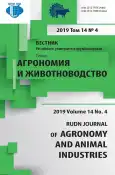Влияние засоления на вегетативный рост и фотосинтетические пигменты горького миндаля
- Авторы: Бадран А.М.1,2, Савин И.Ю.2,3
-
Учреждения:
- Центр исследований пустынь
- Российский университет дружбы народов
- Почвенный институт имени В.В. Докучаева
- Выпуск: Том 14, № 4 (2019)
- Страницы: 319-328
- Раздел: Растениеводство
- URL: https://journal-vniispk.ru/2312-797X/article/view/329155
- DOI: https://doi.org/10.22363/2312-797X-2019-14-4-319-328
- ID: 329155
Цитировать
Полный текст
Аннотация
Ключевые слова
Об авторах
Антар Махмуд Бадран
Центр исследований пустынь; Российский университет дружбы народов
Email: dr_antar_mahmoud@yahoo.com
аспирант, агроинженерный департамент, Аграрно-технологический институт Каир, Египет; Москва, Российская Федерация
Игорь Юрьевич Савин
Российский университет дружбы народов; Почвенный институт имени В.В. Докучаева
Email: savin_iyu@esoil.ru
член-корреспондент РАН, доктор сельскохозяйственных наук, заместитель директора по научной работе; профессор, агроинженерный департамент, Аграрно-технологический институт Москва, Российская Федерация
Список литературы
- Gupta IC. Use of saline water in agriculture. Oxford and IBH Publishing Co. 1979; 2-28.
- Tester M, Davenport RA. Na+ tolerance and Na+ transport in higher plants. Annals of Botany. 2003; 91(5):503-527. doi: 10.1093/aob/mcg058
- Kefu Z, Hai F, San Z, Jie S. Study on the salt and drought tolerance of Suaeda salsa and Kalanchoe claigremontiana under iso-osmotic salt and water stress. Plant Sci. 2003; 165(4):837-844. doi: 10.1016/S0168-9452(03)00282-6
- Castel JR, Fereres E. Responses of young almond trees to two drought periods in the field. Journal of Horticultural Science. 1982; 57(2):175-187. doi: 10.1080/00221589.1982.11515038
- Bernstein L, Francois LE, Clark RA. Salt tolerance in ornamental shrubs and ground covers. Amer Soc Hort Sci. J. 1972; 97:550-556.
- Lipe WN, Crane JC. Dormancy regulation in peach seeds. Science. 1966; 153(3735):541-542. doi: 10.1126/science.153.3735.541
- Miryam O, Moulay B, Narimane Z. Effect of salinity on seed germination of Abelmoschus esculentus. Afr J Agric Res. 2015; 10(19):2014-2019. doi: 10.5897/AJAR2013.8341
- Ayers RS, Westcot DW. Water quality for agriculture. Rome: Food and Agriculture Organization of the United Nations; 1989.
- Yücedağ C, Gültekin HC. Effects of cold stratification and sowing time on germination of almond (Amygdalus communis L.) and wild almond (Amygdalus orientalis L.) seeds. African Journal of Agricultural Research. 2011; 6(15): 3522-3525.
- Pochinok KN. Metody biokhimicheskogo analiza rastenii [Methods of biochemical plant analysis]. Kiev. Naukova Dumka Publ. 1976. (In Russ). Починок Х.Н. Методы биохимического анализа растений. Киев: Наукова Думка, 1976. 336 с.
- Jain VM, Karibasappa GN, Dodamani AS, Mali GV. Estimating the carbohydrate content of various forms of tobacco by phenol-sulfuric acid method. J Edu Health Promot. 2017; 6:90. doi: 10.4103/jehp.jehp_41_17
- Cano EA, Bolarin MC, Perez-Alfocea F, Caro M. Effect of NaCl priming on increased salt tolerance in tomato. J Hort Sci. 1991; 66(5): 621-628. doi: 10.1080/00221589.1991.11516192
- West G, Inze D, Beemster GT. cell cycle modulation in the response of the primary root of Arabidopsis to salt stress. Plant Physiol. 2004; 135(2):1050-1058. doi: 10.1104/pp.104.040022
- Delane R, Greenway H, Munns R, Gibbs J. Ion concentration and carbohydrate status of the elongation leaf tissue of Hordeum vulgare growing at high external NaCl: 1. Relationship between solute concentration and growth. Jour of Exp Botany. 1982; 33(4):557-573. doi: https://doi.org/10.1093/jxb/33.4.557-a
- Bondok A, Ttawfic H, Shaltout AD, Abd-EI-Hamid N. Effect of salinized irrigation water on chemical constituents of Flordaprince prince peach cultivar budded on different peach rootstocks. Assiut J Agric Sci. 1995; 26(1):149-171.
- Wang H, Qi Q, Schorr P, Cutler AJ, Crosby WL, Fowke LC. ICK1, a cyclin-dependent protein kinase inhibitor from Arabidopsis thaliana interacts with both Cdc2a and CycD3, and its expression is induced by abscisic acid. Plant J. 1998; 15(4):501-510. doi: 10.1046/j.1365-313X.1998.00231.x
- Shibli RA, Shatanawi MA, Swaidat IQ. Growth, osmotic adjustment and nutrient acquisition of bitter almond under induced sodium chloride salinity in vitro. Communications in Soil Science and Plant Analysis. 2003; 34(13-14):1969-1979. doi: 10.1081/CSS-120023231
- Winter E. Salt tolerance of Trifolium alexandrinum L. II. Ion balance in relation to its salt tolerance. Australian Journal of Plant Physiology. 1982; 9(2):227-237. doi: 10.1071/PP9820227
- Niu X, Bressan RA, Hasegawa PM, Pardo JM. Ion homeostasis in NaCl stress environments. Plant Physiol. 1995; 109(3):735-742. doi: 10.1104/pp.109.3.735
- Bernstein L, Francois LE, Clark RA. Salt tolerance in ornamental shrubs and ground covers. Amer Soc Hort Sci J. 1972; 97:550-556.
- Reddy MS. Metabolism of chloroplasts isolated from leaves of ground nut plant (Arachlshypogaea) grown in normal salinized and alkalized soils. [Ph.D. Thesis] Tirupati; 1976.
- Patil GP, Boswell MT, Ratnaparkhi MV. Dictionary and classified bibliography of statistical distributions in scientific work, Vol. 2: Continuous univariate models. Burtonsville, MD: International Cooperative Publishing House; 1984.
Дополнительные файлы










